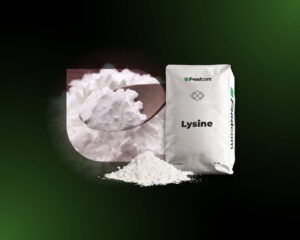- Increased costs and supply chain disruptions – Rising raw material and energy prices as well as logistical problems have affected lysine supply and prices.
- Impact of regulation and anti-dumping duties – The European Union has imposed duties on Chinese lysine, forcing importers to look for new suppliers.
- Market diversification and new applications – In addition to the feed sector, lysine is gaining importance in pharmaceuticals and food supplements.
- Forecasts for 2025 – Key trends include price stabilisation, the development of green production methods and the search for alternative raw material sources.
In 2024, the global lysine market faced a number of challenges from rising raw material costs, supply chain disruptions and regulatory changes. As an important amino acid used in the feed industry, lysine remains an indispensable part of the diet of farm animals, and its production and prices are closely linked to the situation in the agricultural sector and the availability of basic raw materials such as corn and soybeans. However, lysine is also increasingly used in nutritional supplements and pharmaceuticals, which further influences the dynamics of the market.
Global lysine market analysis 2024
At the beginning of the year, producers were faced with the problem of rising energy and raw material costs, which put pressure on supply and pushed up lysine prices on the world market. The first quarter saw an average price increase of 12% compared to the same period in 2023, and the following months only consolidated the upward trend. This was particularly noticeable in Europe, where rising feed prices forced greater caution in purchasing, and some farmers began to look for alternative sources of amino acids. In Asia, and especially in China, the demand for lysine remained stable, supported by the recovery of the pig sector and the increase in poultry production.

In 2024, the lysine market was under strong cost pressure. The prices of corn, which is the main raw material for its production, as well as regulatory changes in Europe, were of great importance. After the introduction of anti-dumping duties on Chinese lysine, importers began to intensively search for alternative suppliers, which may lead to a reshuffling of forces in the global market in the long term. At the same time, the growing popularity of lysine in the pharmaceutical and supplement industries is opening up new opportunities for producers, which could offset the decline in demand in the feed sector over time.
In addition to the feed sector, there is growing interest in lysine in the pharmaceutical and supplement industries. In the USA, Canada and Europe, the growing awareness of the role of amino acids in the diet has translated into an increase in demand for supplements with lysine, supporting immunity, herpes treatment and bone and muscle health. Particularly dynamic growth has been observed among athletes and people on plant-based diets, where lysine supplements protein deficits.
Logistical factors also had a significant impact on the market. Disruptions to transport routes, including the temporary blockage of the Suez Canal and problems with the availability of containers in Asian ports, led to delays in deliveries and increased import costs. The European market also struggled with the consequences of new customs regulations that introduced temporary anti-dumping duties on lysine imports from China. These restrictions were intended to protect local producers, but at the same time they caused prices to rise further and limited the availability of the product on the European market.
We encourage you to read the interesting article: Lysine and its applications in animal nutrition
Regional analysis of the lysine market
In 2024, the global lysine market was characterised by varying dynamics in individual regions, resulting from local economic, political and climatic conditions.
North America
In the United States, the lysine market remained stable, but producers struggled with rising raw material costs, especially for corn, which led to an increase in production prices. In addition, trade tensions with China and potential restrictions on soya exports could have affected the availability of raw materials necessary for lysine production. The situation in Canada was similar, with an emphasis on maintaining supply stability in the face of global logistical disruptions.
Europe
The European lysine market experienced significant changes in 2025. The introduction of temporary anti-dumping duties on lysine imports from China by the European Union aimed to protect local producers from unfair competition. This decision caused lysine prices to rise on the European market and forced importers to look for alternative sources of supply. In countries such as Germany and France, there was an increased interest in local production and diversification of import sources.
Asia
China, as one of the world’s largest lysine producers, continued to expand into international markets. However, the introduction of anti-dumping duties by the European Union and trade tensions with the USA made it necessary to look for new markets in Asia and Africa. In India and Southeast Asia, demand for lysine has increased due to the development of the feed industry and the growing awareness of the importance of amino acid supplementation in animal husbandry.
Latin America
In Brazil and Argentina, the key producers of soya, the primary raw material for lysine production, a stable increase in production was observed. Favourable climatic conditions and investments in modern agricultural technologies contributed to increased yields, which had a positive impact on the availability of raw materials for lysine producers in the region.
Africa
The lysine market in Africa is still in its infancy. However, increasing investments in the agricultural and livestock sectors, especially in countries such as Nigeria and Kenya, indicate the potential for growth in lysine demand in the coming years. Challenges related to infrastructure and access to modern technologies may, however, delay the dynamic development of this market segment.
2025 – trends and forecasts for the lysine market
After the dynamic changes in the lysine market in 2024, the coming months will be crucial in determining whether the sector will enter a phase of stabilisation or face further uncertainty. Faced with global challenges such as trade tensions, regulatory changes and increasing pressure on sustainable production, companies operating in the lysine industry will have to adapt their strategies to remain competitive.

The lysine market is at a crossroads. On the one hand, there are rising production costs due to the limited availability of raw materials and energy, and on the other hand, there is the progressive diversification of supply sources. Strategic changes in supply chains will be one of the most important trends in 2025. After the introduction of anti-dumping duties on Chinese lysine, European importers are actively looking for new suppliers in South America and Southeast Asia. We can expect increased production in these regions to stabilise prices to some extent, but at the same time it will open up new challenges in terms of logistics and compliance with EU regulations on the carbon footprint.
In 2025, the development of modern lysine production methods aimed at reducing CO₂ emissions and energy consumption will play a special role. The exploration of alternative raw material sources, such as agricultural waste, may become a new trend that will reduce dependence on corn and soy. At the same time, the growing interest in lysine in the pharmaceutical and supplement sectors is opening up new prospects for producers, especially in developed countries where consumers are increasingly turning to functional products that support immunity and muscle regeneration.
The impact of climate change cannot be ignored either. Unstable weather conditions in key raw material production regions such as Brazil and the USA may continue to affect supply, which, combined with increasing regulatory requirements in Europe, will require flexible purchasing strategies.
All in all, 2026 could be a period of stabilisation for lysine prices, provided that supply sources are successfully diversified and production technologies are further developed. Companies that adapt to the new market realities early on will have the best chance of strengthening their position in the industry.
Global Reports from Foodcom S.A.
Curious about what’s next for lysine? Discover the latest trends and insights that will shape the next months of 2025. Visit our blog as we regularly update our global reports. Stay tuned with Foodcom S.A.
![Lysine market review 2025 [Global Report] Lysine market review 2025 [Global Report]](https://foodcom.pl/wp-content/uploads/2025/02/przeglad-rynku-lizyny-w-2025-1520x760.png)


![Przegląd rynku WPC 80 2025 [Raport globalny] Przegląd rynku WPC 80 2025 [Raport globalny]](https://foodcom.pl/wp-content/uploads/2024/11/global-report-wpc-300x150.png)
![Analiza rynku skrobi ziemniaczanej 2025 [Global Report] Analiza rynku skrobi ziemniaczanej 2025 [Global Report]](https://foodcom.pl/wp-content/uploads/2024/09/potato-starch-300x150.png)
![Analiza rynku białka grochu 2025 [Global Report] Analiza rynku białka grochu 2025 [Global Report]](https://foodcom.pl/wp-content/uploads/2024/10/pea-protein-blog-300x150.png)


